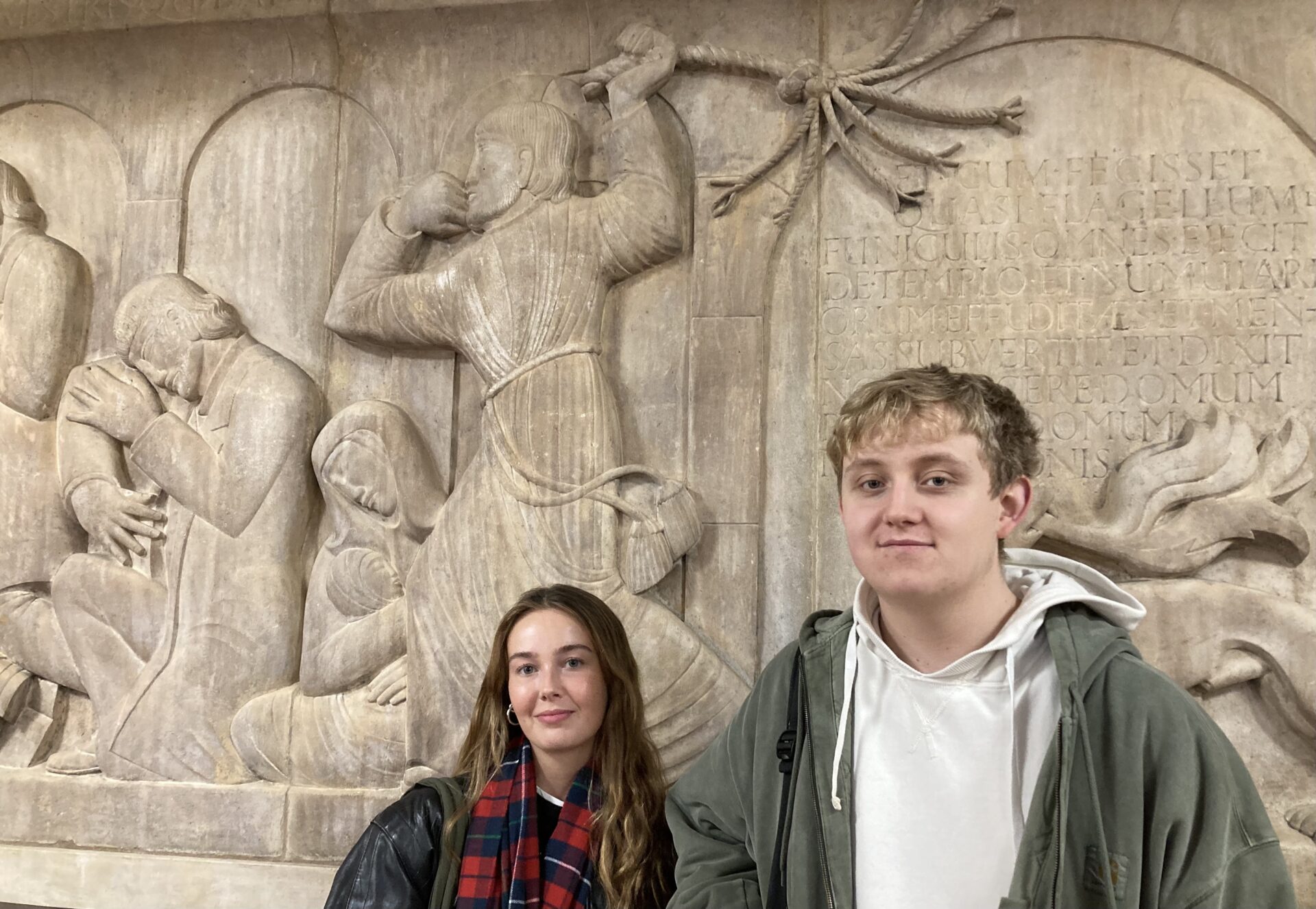Abusive Religious Art in Public - Students Speak Back

This post is by Joey Stoole and Annelise Maynard, Liberal Arts students here at the University of Leeds. As part of one of their modules, they have been researching topics at the intersection of religion and abuse. Here they take head-on the public display of a work of art by Eric Gill, which is inspired by a story in the New Testament.
Prominently on display in the foyer of the Michael Sadler Building, in the heart of the University of Leeds campus, is a grand limestone frieze by the highly controversial British artist Eric Gill. The sculpture depicts the biblical story taken from Matthew 21 of Jesus driving the money changers from the temple. Behind its splendour, however, lies a story steeped in spiritual abuse, war, and sexual misconduct that is not discussed enough within our university. While Gill is credited for the frieze on the small plaque accompanying it, the absence of any reference to the abusive connotations of the biblical story or Gill’s extensive history of sexual violence is glaringly evident.
As student researchers in the project "Handling Sexual Abuse Scandals in Churches: A Toolkit", we were encouraged by our supervisor Johanna Stiebert to uncover the symbolism and intentions of the artwork we unknowingly walk past every week. The frieze was commissioned by Michael Sadler, then the university's vice-chancellor, in 1917 to commemorate the First World War. Originally displayed outside the Great Hall, the frieze was subsequently moved to the foyer of the Michael Sadler building where it can still be seen today.
The stone frieze depicts the story of Jesus driving the moneylenders from the temple, a biblical passage most famously known for the quote “It is written,” he said to them, “My house will be called a house of prayer, but you are making it a den of thieves”. As recorded in the Bible, Jesus did not just morally disagree with the actions of the moneylenders he violently whipped them. While the extract is often used as an example of Jesus denouncing greed and the corruption of faith, it is commonly used to exemplify Jesus as more than a meek pacifist and in doing so, justifies religiously based violence. This highlights how spiritual abuse – the use of one's spiritual beliefs to manipulate or cause harm – could controversially be justified through this piece of art, especially with its prominent display in a scholastic environment.
In our collaborative research on Gill's sculpture, we uncovered several notable aspects that merit further exploration. One such aspect is Gill's stylistic choice to depict the moneylenders in contemporarily modern clothing, perhaps suggesting that Gill’s interpretation aligns with the narrative of Jesus' actions as depicted in the original story. In this work, Gill was also commenting on issues of corruption and exploitation contemporary to the time, directing specific critique towards the merchants of Leeds that profited from the First World War.
Furthermore, the frieze raises questions about the portrayal of violence and its implications, particularly when considering Gill's troubling past of self-admitted pedophilia, incest, and bestiality. While Gill’s personal history may not directly influence our interpretation of the sculpture, it prompts reflection on the broader context in which his work is displayed. By featuring Gill's sculpture prominently without any critique or even acknowledgement of his perverse transgressions, there's a risk of tacitly condoning his actions and normalising harmful behaviours, particularly concerning sexual abuse. Moreover, the subject matter of the sculpture, depicting Jesus' cleansing of the temple, can be viewed through various lenses, including its potential to perpetuate harmful stereotypes, such as those with antisemitic connotations. Without mechanisms in place to provide contextual information and allow engagement of discussion, the sculpture's presence on such a diverse campus could inadvertently elevate certain religious narratives over others, potentially marginalising members of our university.
The decision to display Gill's work raises broader questions about the role of art in public spaces and the responsibilities of institutions in addressing the problematic parts of artists' histories. Should there be systems in place to draw attention to Gill's crimes or to prompt critical reflection on how the sculpture might be interpreted in contemporary society? Does its presence inadvertently glorify a sex offender, particularly on a campus where sexual abuse remains a pressing concern? These questions highlight the complex ethical considerations surrounding the display of art created by individuals with disturbing pasts.
Ultimately, the prominent display of Eric Gill’s stone frieze raises questions about the suitability and morality of its spectacle for a myriad of reasons. Primarily, the spiritually abusive undertones that can be derived from the bible story and Gill’s artistic interpretation of it. But more significantly, the way Gill’s immoral actions throughout his life may have contributed to this interpretation. For these reasons, we believe that the display of this piece of art is unjust and promotes both religiously based abuse and sexual violence within a university that is supposedly against it. Although there is no mention of Gill’s actions on the plaque displayed alongside the frieze, the university website does label Gill as “a controversial figure”. Despite this however, no change has yet been made to the display of Gill’s work, making it impossible for passers-by to be aware of the many complex issues that surround both this work of art and its creator.
Joey Stoole is a second-year Liberal Arts student at the University of Leeds. Majoring in Politics, he aims to take full advantage of the interdisciplinary nature of the Liberal Arts degree to aid the development of skills, with the ultimate hope of a future career in law.
Annelise Maynard is in her second year at the University of Leeds, studying Liberal Arts, with a focus on English Literature. She views the Arts as a means of reflecting on histories, shifts in social perceptions and miscarriages of justice. Taking an interdisciplinary outlook on society, literature and art, Annelise hopes to share her passion for social justice and to encourage others, too, to stand up for what they believe in.

NB. Joey and Annelise, together with Maya and Bradley, are now working on the next part of their project. Here they are shown together with Heston and Penny at All Hallows Church. Look out for their podcast (in production).
